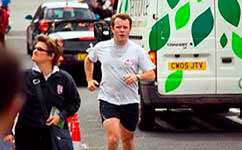Joggers are at higher risk of air pollution than walkers are

Joggers who run near busy roads may be putting themselves at a higher risk of breathing in air pollution compared to if they walked at an average pace, say scientists.
The researchers wanted to know how the risk of inhaling air pollution changes depending on how long a journey takes.
They found that the longer someone is exposed to air pollution is finely balanced with how much an individual inhales in each breath.
'How much you're breathing in depends on how long you're in a heavily polluted environment for,' says Gemma Davies, a PhD student atLancaster University and lead researcher on the study. 'You might think that walking faster from a-to-b will mean less exposure, but that's only if your breathing rate is constant. In actual fact, as you walk faster your breathing rate increases, so you inhale more.'
Air pollution has been shown to cause headaches, an increase in people diagnosed with asthma, and long-term, it can cause heart disease and even cancer.
A standard walking pace turned out to be best way to reduce exposure, going slower meant more time spent in the environment while going faster meant breathing more air pollution in.
Joggers who run near roads could be inhaling up to a third more air pollution than if they just walked at a normal rate.
'The health benefits of running probably outweigh the inhaled dose, but on heavily polluted days jogging by busy roads could make a difference,' says Davies.
Weight, height and gender were all shown to make a difference in how much air pollution people inhaled.
'We also found that generally exposure increases with age. So if two people - one aged 25 and the other 65 - are walking at the same pace, the 65 year old is more vulnerable and will have a greater inhaled dose,' says Davies.
'People who are heavily overweight also inhale more,' she adds.
To test how much air pollution people breathed in, Davies used the city of Lancaster as a case study. She mapped both the fastest route people might take between their schools or work and home and the route with the least exposure to air pollution. She found that the route with least exposure changed each day depending on a number of factors.
'Much of the time you can help reduce your exposure by choosing alternative low exposure routes, unless you are talking about extreme conditions such as the recent pollution episode where man-made and natural sources combined to produce an environment in which anyone doing vigorous exercise should probably have had to take care,' says Davies.
The team also found that a small change in your journey, such as walking on a different side of the road, could make a difference as to how much pollution you inhale.
'Mostly it's a question of wind direction. It doesn't always make a difference, but whether you're upwind or downwind of pollution source, normally road-based pollution, can change how much pollution you're breathing in. On a completely still day it will have little impact,' Davies explains.
More information: Gemma Davies, J. Duncan Whyatt (2014) "A network-based approach for estimating pedestrian journey-time exposure to air pollution" Science of The Total Environment Volumes 485-486, Pages 62-70
This story is republished courtesy of Planet Earth online, a free, companion website to the award-winning magazine Planet Earth published and funded by the Natural Environment Research Council (NERC).
















